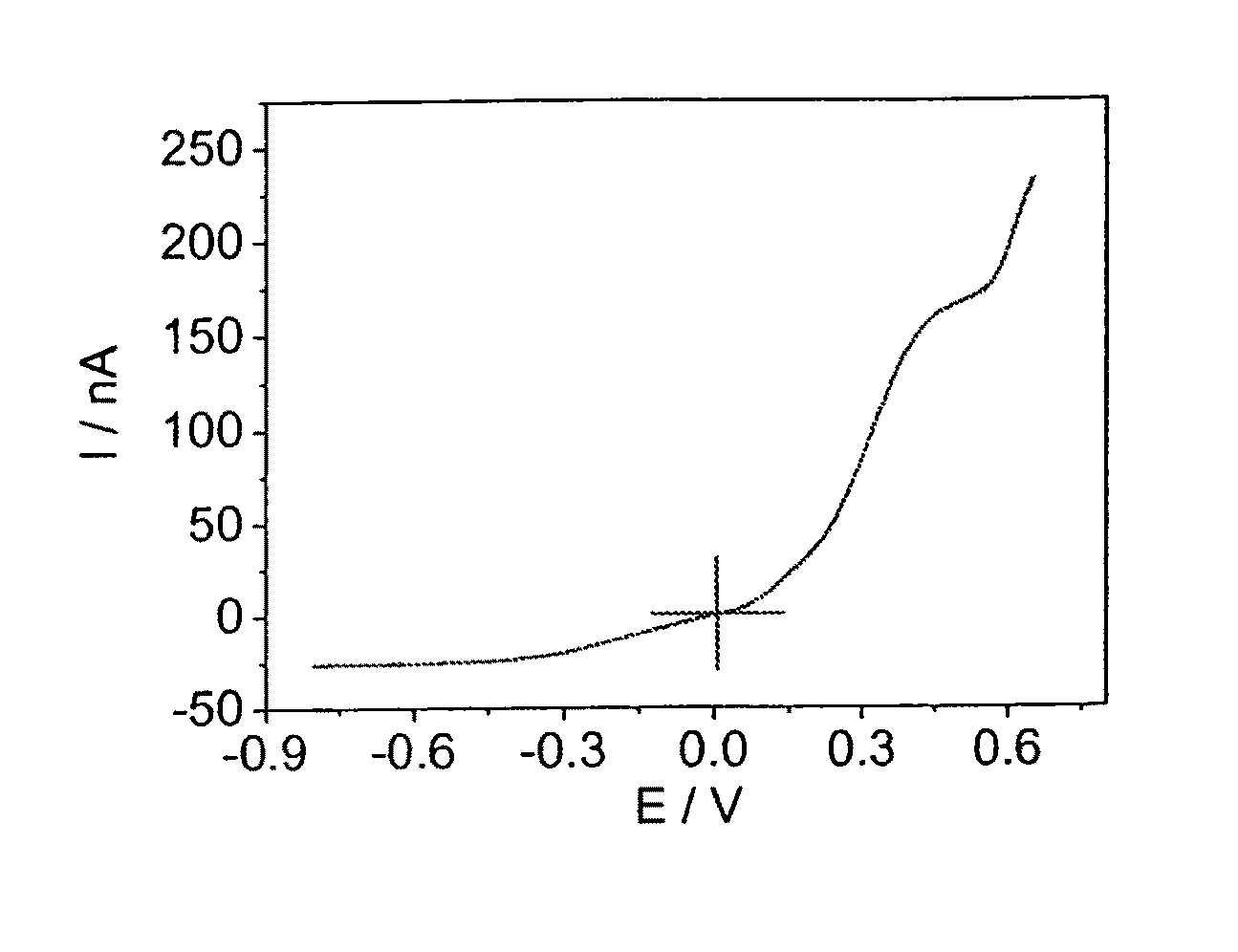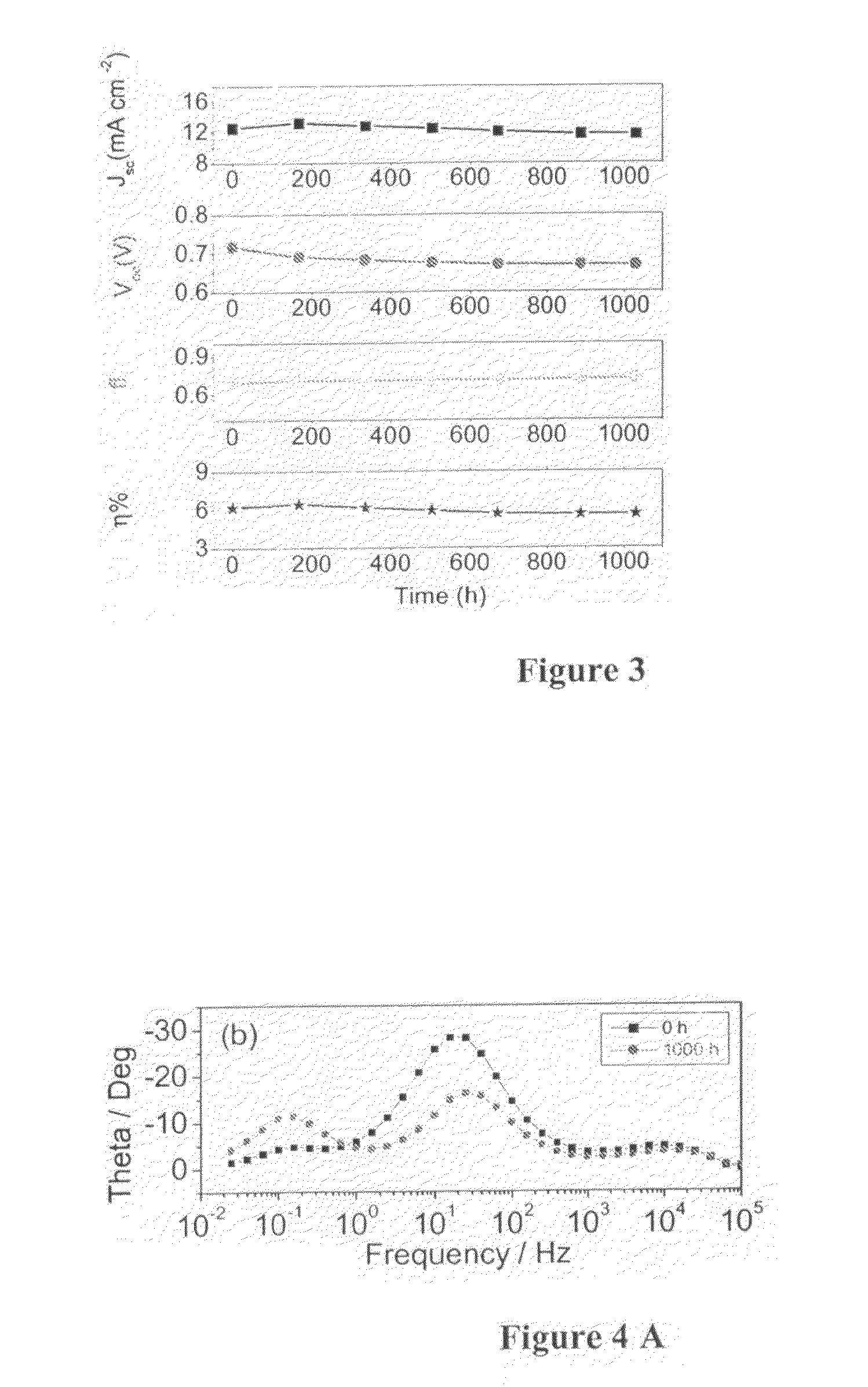Ionic liquid electrolyte
a liquid electrolyte and ionic liquid technology, applied in the direction of electrolytic capacitors, pv power plants, electrochemical generators, etc., can solve the problems of high viscosity, high viscosity, and loss of photovoltaic performance under prolonged thermal stress at 80° c, so as to improve the performance and stability of electrochemical and/or optoelectronic devices
- Summary
- Abstract
- Description
- Claims
- Application Information
AI Technical Summary
Benefits of technology
Problems solved by technology
Method used
Image
Examples
example 1
Ionic Liquids, Electrolytes and Diffusion Coefficient
[0091]A ionic liquid EMIB(CN)4 (1-ethyl-3-methylimidazolium tetracyanoborate) was obtained from Merck, Germany. Its synthesis is further disclosed in WO 2004 / 072089, page 18, Example 9. The viscosity of EMIB(CN)4 is 19.8 cP at 20° C.
[0092]A binary ionic liquid, “electrolyte A” was composed of 0.2 M I2, 0.5 M NMBI (N-Methylbenzimidazole) and 0.1 M guanidinium thiocyanate (GuNCS) in a mixture of PMII (1-methyl-3-propylimidazolium) iodide and EMIB(CN)4 (volume ratio: 13:7). PMII was prepared according to Bonhôte, P. et al Inorg. Chem. 1996, 35, 1168-1178.
[0093]For comparison, another binary ionic liquid electrolyte B was prepared using 0.2 M I2, 0.5 NMBI and 0.1 M GuNCS in PMII.
[0094]The diffusion coefficients of iodide and triiodide were measured as described in Bard, A. J.; Faulkner, L. R. Electrochemical Methods: Fundamentals and Applications, 2nd ed: Weinheim, 2001. The apparent diffusion coefficient of iodide and triiodide calcu...
example 2
Fabrication of Dye-Sensitized Solar Cells
[0096]A double-layer, mesoporous TiO2 electrode was prepared as disclosed in Wang, P., Zakeeruddin, S. M., Comte, P., Charvet, R., Humphry-Baker, R. Grätzel M., Enhance the Performance of Dye-Sensitized Solar Cells B Co-Grafting Amphiphilic Sensitizer and hexadecylmalonic Acid on TiO2 Nanocrystals M. J. Phys. Chem. B 2003, 107, 14336, in particular page 14337, in order to obtain a photoanode consisting of a double layer structure, with a transparent layer (20 nm particle) and scattering layer (400 nm particle) of 6.8 μm and 4 μm thickness, respectively.
[0097]The electrode was sintered and coated with Z-907 Na dye by dipping it into the dye solution as disclosed in the same reference above (300 μM Z-907Na is disclosed in Wang Peng, Wenger B, Humphry-Baker R, Teuscher J, Kantlehr W, Mezger J, Stoyanov E:V, Zakeeruddin Shaik M and Graetzel M; Charge separation and efficient light energy conversion in sensized mesoscopic solar cells based onbinar...
example 3
Characteristics of the Dye-Sensitized Solar Cells
[0099]The measurement of current-voltage curves and incident photon-to-current conversion efficiency (IPCE) of the cells were obtained by using a Keithley model 2400 digital source meter (Keithley, USA) under an applied external potential bias as reported in the reference cited above of Wang et al J. Phys. Chem. B 2003, 107, 14336.
[0100]The photocurrent-voltage curves of devices A based on Z-907Na sensitizer and electrolyte A measured under AM-1.5 full sunlight illumination is shown in FIG. 2.
[0101]The photocurrent action spectrum of devices A (inset of FIG. 2) shows that the incident photon to current conversion efficiency (IPCE) is close to 80% at 530 nm. Detailed photovoltaic conversion efficiencies of devices A and B at various light intensities are shown in Table 1 below.
[0102]
TABLE 1Photovoltaic parameters of devices A and B at different light intensitiesη (%) at different light intensityElectrolyte1.0 sun0.5 sun0.3 sunA6.47.17....
PUM
| Property | Measurement | Unit |
|---|---|---|
| vol. % | aaaaa | aaaaa |
| melting point | aaaaa | aaaaa |
| temperature | aaaaa | aaaaa |
Abstract
Description
Claims
Application Information
 Login to View More
Login to View More - R&D
- Intellectual Property
- Life Sciences
- Materials
- Tech Scout
- Unparalleled Data Quality
- Higher Quality Content
- 60% Fewer Hallucinations
Browse by: Latest US Patents, China's latest patents, Technical Efficacy Thesaurus, Application Domain, Technology Topic, Popular Technical Reports.
© 2025 PatSnap. All rights reserved.Legal|Privacy policy|Modern Slavery Act Transparency Statement|Sitemap|About US| Contact US: help@patsnap.com



